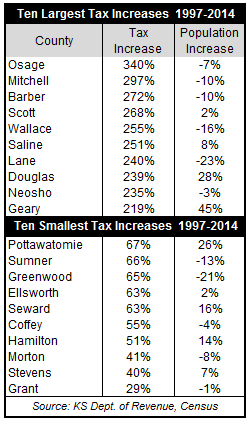The beat goes on, The beat goes on 
Drums keep pounding a rhythm to the brain
La de da de de, la de da de da
I’m reminded of this chorus from a Sonny and Cher song every year when new property tax data is released, with a slight variation. Taxes keep pounding people to the ground. La de da de de, la de da de da.
The new county property tax data for 2014, which excludes cities, school districts and other jurisdictions, shows the beating definitely is going on. Over the last seventeen years, 66 counties had population declines AND county property taxes increases that are greater than the rate of inflation. That is the definition of an excessive tax burden increase on remaining residents, and one must wonder how much those tax burden increases act as a disincentive to population and economic growth in those counties.
 The average county property tax increase is 124%. Only 3 counties increased property taxes less than the rate of inflation.
The average county property tax increase is 124%. Only 3 counties increased property taxes less than the rate of inflation.
- 31 counties increased taxes between 44% (inflation) and 100%.
- 56 counties increased between 100% and 200%.
- 14 counties increased between 200% and 300%.
- Osage county property taxes were the worst…at 340%, with a 7% population decline.
A list of all 105 counties with property tax and population change can be downloaded here. Additional information on large cities and property tax changes inclusive of all jurisdictions within each county is available at KansasOpenGov.org.
There are several reasons why property taxes have gotten so out of control. For starters, Kansas has 32% more local government employees than the national average (employees per 10,000 residents) and is the 49th worst state in the nation on that basis. That lousy ranking is mostly caused by having too many local government entities. Kansas has 1,997 general purpose governments (cities, counties and townships) and therefore only 1,449 residents per general purpose government. With the national average at 8,108 residents per GPG, Kansas has more than 5 times the national average of local governments on a residents-per-GPG basis! See pages 15 through 18 in the 2014 Kansas Green Book for sourcing and more information.
Also, the process is heavily stacked in government’s favor. Government decides the value of one’s property and then sets the tax rate based on what it wants to spend. There is no consideration of the ability to pay and the appeals process is stacked in government’s favor (although last year’s legislative reforms were good improvements).
There simply is no incentive for local government to operate efficiently. Cities and counties decide what they want to spend and send you the bill. The Senate tried to prevent cities and counties from increasing property tax on existing construction by more than inflation without voter approval, but the House took government’s side and watered the proposal down with lots of exceptions. The legislation that was finally approved is pretty weak and doesn’t even go into effect until 2018.
Cities and counties have taken advantage of citizens for far too long (and haven’t even been honest about the amount of increase). At the very least, the Legislature should require a public vote for any tax increase that exceeds inflation. No exceptions, all tax increases count (including from new construction) and no three-year delays. Local government will fight hard but 2016 is an election year for the House and Senate, so maybe legislators will want to do something positive for citizens.
If not, the tax beating will go on…and cities and counties will be singing the same old song.
La de da de de, la de da de da



